
Perceiving News Media as a Threat
President Trump’s ongoing attacks on news organizations and journalists, in which he frequently calls legitimate news organizations “FAKE NEWS” and “the enemy of the people,” are at least in part responsible for recent Pew Research findings that Americans increasingly view news media as untrustworthy and partisan. Similarly, a recent survey-based study published in the National Communication Association’s Journal of Applied Communication Research shows that a “significant portion of the U.S. population has established extreme positions in the ongoing debate between the Trump administration and the press.” Researchers Nicholas W. Robinson and R. Lance Holbert explored survey respondents’ perceptions of the news media industry as a threat to political performance and their own political behaviors, such as news media exposure, political talk, and voter participation.
[A] "significant portion of the U.S. population has established extreme positions in the ongoing debate between the Trump administration and the press."
The authors asked 2,052 adults in the United States to rank themselves on a political ideology scale, and 14.4 percent indicated they were “very conservative” versus 10.1 percent selecting “very liberal.” The largest group (40 percent) responded that they were “moderate.” When asked about their political party affiliations, roughly one-third of respondents reported that they were Democrats and nearly 24 percent said they were Republicans.
The primary focus of the study was to gauge the degree to which American citizens viewed the news media as a threat to democracy. While 18.4 percent of the respondents did not consider the news media to be a threat whatsoever, a roughly equal percentage (18.7 percent) perceive the news media industry to be an extreme threat to democracy. These two groups varied in terms of political party identification, political ideology, age, and race. The high-threat group consisted of more Republicans while also being more conservative, younger, and with a higher percentage of Caucasians. The biggest difference between the two groups was in relation to political ideology. However, these two groups were very alike in terms of gender breakdown, education levels, and household income. They also shared similar levels of political engagement and did not differ in the amount of news media they consumed. In short, the researchers found that “the two groups were far more alike than distinct from one another but held radically different perceptions of the news media industry.”
The researchers provide important insights that can help news organizations and communication professionals gain a better understanding of their audiences. Two notable insights are:
- Do not assume that those who view the media as a threat are poorly educated about politics and journalism; the data showed the opposite is true.
- The high news-media-as-threat citizens consume just as much news as the low-threat citizens, and both of these groups take in more news than the folks who perceive the news media to be a moderate threat.
Given the study findings, while political polarization is one factor shaping public perceptions of journalists, the researchers recommend that news organizations avoid attributing increasing distrust and declines in public confidence of the media to ideological factors alone.
This essay was translated from the scholarly article: Nicholas W. Robinson & R. Lance Holbert “Taking sides in the war on news: exploring curvilinear associations and group differences related to perceptions of news media as threat.” Journal of Applied Communication Research. doi: 10.1080/00909882.2018.1548028



